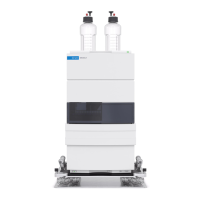126 1220 Infinity II LC System User Manual
8
Detector Description
Agilent 1220 Infinity II LC Diode Array Detector (DAD)
A wide bandwidth has the advantage of reducing noise by averaging over a
wavelength range — compared to a 4 nm bandwidth, the baseline noise is
reduced by a factor of approximately 2.5, whereas the signal is about 75 % of a
4 nm wide band. The signal-to-noise ratio for a 30 nm bandwidth is twice that
for a 4 nm bandwidth in our example.
Figure 39 Influence of Bandwidth on Signal and Noise
Because the detector averages absorbance values that are calculated for each
wavelength, using a wide bandwidth does not negatively impact linearity.
The use of a reference wavelength is highly recommended to further reduce
baseline drift and wander induced by room temperature fluctuations or
refractive index changes during a gradient.
An example of the reduction of baseline drifts is shown in Figure 40 on
page 127 for PTH-amino acids. Without a reference wavelength, the
chromatogram drifts downwards due to refractive index changes induced by
the gradient. This is almost completely eliminated by using a reference
wavelength. With this technique, PTH-amino acids can be quantified in the low
picomole range even in a gradient analysis.

